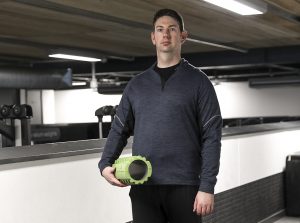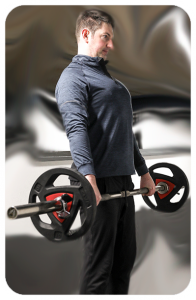


Mental Health in Lockdown 2.0
Mental Health in Lockdown 2.0 Richard Kelly 18th November 2020 I’m sure we could all sit here and discuss the


Deadlifts. These days they are perceived as a measure of strength, a staple of any serious resistance training programme. But it wasn’t long ago that no one did them, that the vast majority considered them dangerous, something that powerlifters did but little else.
I have a varied and interesting history with deadlifts. I think the first time I deadlifted was around 2010. Certainly I did not deadlift regularly until 2011. If that seems relatively recent it is because deadlifts are amongst a number of lifts have come back into favour in the past decade. In the 2000s, when I started exercising regularly, deadlifts were seen as an old school movement favoured by old school lifters.
They were done by old men in the gym, the same guys who favoured behind the neck lat pulldowns. You will have seen these guys; incredibly strong, often with bad posture and gym attire that hasn’t been updated in twenty years. They interact with virtually everyone in the weights area, young and old alike. These were virtually the only people deadlifting in gyms in the 2000s.
Deadlifts at the time were just seen as too dangerous, an unnecessary risk to the spine and back. A succession of physios and chiropractors had blamed disc injuries on these type of lifts. Why risk these problems when there were other, safer, movements that could be done that worked the muscles worked in the deadlift just as well? Lets not also forget that in the 90s, not long before the time we are talking about, that there was a pervading belief that weight training was done by gorilla looking men who all took steroids. Resistance training was still treated with a level of suspicion as a result.
That belief changed in the 2000s, somewhat helped by the rise of CrossFit. A number of prominent strength and conditioning coaches also revealed that they regularly incorporated deadlifts into their training programmes and had had significant results. This combination encouraged trainers, and as a consequence their clients, back into the weights area to deadlift. This was a big step away from the trend at the time, which had been towards using machines to replicate the big resistance movements.
I cannot tell you how big a transition that was. I can remember going to the gym in 2005, and the only lower body exercises anyone did were machine based. Five years later and squats and deadlifts were even being trained by bodybuilders. They had returned to the mainstream in the gym. Machines dominated gyms in the 2000s. In the 2010s it was free weights. In 2005 machines were still the focal point for most lifters, in part because they were easy to understand what to do and in part because it was believed that they were safer than free weights. But through the 2000s that belief started to change. Limitations were found with using machines, and a rediscovery of some of the old lifts started to return.
In 2011 I started working in gyms. And that year I decided to start deadlifting regularly. I recall a point in time where I decided that they must be safer than I had thought because Paul Chek did them, but that Mike Boyle was right, that unilateral strength was more significant than bilateral. This means that single leg strength is more important that demonstrating strength from a planted foot position, as most functional uses of strength are from a single leg position.
I wanted to master the movement in order to teach the movement. So, through the books I had and conversations with some of my peers I began to piece together the teaching points and significant technique of the movement.
In the beginning my technique was rather terrible. My posture position wasn’t good, and my grip wasn’t strong. My legs were strong enough, but that led to an over-reliance on leg strength in the lift. My other big limitation was a lack of mobility. This meant that at relatively light weights my issues were not exposed. But at a heavy weight that I required technique to lift safely I lacked the ability to get into position and correctly load my body.
The result was that I got injured.
I’ve always been afraid of exposing my back to injury in the deadlift. I’m sure in part it was all the stories I heard in my first few years in the gym about disc injuries from deadlifting. That undoubtedly played a part in the few I had in the lift. I’ve also had a number of back pains as a result of questionable form in the movement, and the net result was that I became wary of the movement. This first time my back was incredibly sore, and subsequently when I got back to deadlifting two weeks later I tried to alter my positioning, assuming that would solve the whole thing.
It did not.
As had happened before my back was sore and I felt the movement was overloading my spine too much. My next move was to focus on improving posture and grip. It I could get my upper back stronger, my chest and shoulders more flexible and my grip stronger I would be able to deadlift much better. Grip seemed to me to be the most significant factor, because partly I felt the weight was slipping from my hands, and that was compromising my positioning in the lift. Looking back now it is clear to see that my postural positioning was more significant.
A combination of stronger grip and better posture did make a big difference, and slowly I made my way up to lifting 100kg. It was at this point where my back felt on the edge of being exposed in the lift, and I had an excessively sore back after each session. Or at least that’s how I felt.
As I mentioned earlier I’ve always had concerns around injuring my back in exercise, and deadlifts are one of those movements which at the time I’d felt most exposes you. Therefore whereas with soreness in my legs from squats, which I would ignore and train through, with my back I would wait until the soreness had diminished and then resume. I was incredibly cagey with the deadlift. This approach meant that after some deadlift sessions it could be a month or more before I resumed deadlifting. My progress in the early years of doing this lift was haphazard at best; it was more occasional lifting followed by boughts of strength and stability work around the lift in order to deadlift better.
It was probably after a year of occasional deadlift training that I actually worked on my mobility as a focus, and then only in a general way. It was also that year that I was exposed to Romanian deadlifts and Sumo deadlifts. These helped my grip and posture as well as my leg strength, but they did not improve my back strength. What they enabled me to do was work around my perceived back weakness, and use the deadlift to work my legs. The result of which was that my Romanian deadlift was at one stage stronger than my conventional deadlift!
In the following year, having, I felt, injured my back again from conventional stance deadlifts, I started to work meticulously on my core. This did help a lot, but now instead of my poor form stopping me around 100kg, now I was being stopped at 110kg.
A lot of this was me dancing around the major issue; my lower back was not strong enough. My grip strength and posture had improved immeasurably; they were no longer the limitation. My limitation was my lower back. But I was paranoid about exposing my lower back. I want to make this clear, because one of the limitations any trainer has is that they often don’t have a regular training partner working towards the same goals as them. Trainers tend to get a lack of objective feedback on either their technique or their training programme. And because I was responding to the signals from my body I was associating the pain I was getting in my back as negative.
This meant that each time it occurred I would go right back to form and begin working with light weights again. And this is a problem, because I had gone far too light, where I was far stronger than the weight lifted and my technique, no matter the look of it, didn’t impact my back. And if my back wasn’t impacted I saw that as a green light to progress. Each time I came back to deadlifts my entire focus was not to injure my back in the movement, rather than to move well through the movement.
More than the physical issue of the relative strength of my lower back, this was actually more a psychological issue. I had been told repeatedly in the outset of training that deadlifts can damage the discs. Its clear when looking at the mechanics of the movement that could be the case and there are instances where I know people who have actually injured their discs in the movement. Therefore my fears of something similar happened to me was not completely unfounded. Nevertheless, this was a movement I was not willing to take any risks in. As soon as I got feedback from my body that there was any pain in the movement I back off and went back to basics. The psychological component was what was restricting me.
In 2014 I worked off blocks. This took away a lot of my mobility issue. It therefore reinforced to me the importance of technique through the movement. It also probably helped my upper back make significant progress in strength which benefitted my postural position in the movement. 2014 was also the first time I started to regularly deadlift, on a weekly basis.
It was only in 2015 that I started to deadlift exclusively in a sumo stance. This positioning required less mobility than I needed in a conventional stance. I figured that by focusing on deadlift mobility and by training in sumo stance I could make quicker progress when I went back to conventional lifting once my mobility had improved.
But it never occurred.
My mobility did improve, but my issue was always that final five centimetres from the ground. On lighter weights that meant I loaded my lower back in the first part of the lift. On heavier lifts I felt I was damaging my back. I just couldn’t get that last bit of range from mobility movements. So sumo deadlifts became my go to deadlift.
In late 2016 into early 2017 I decided to set myself the goal of deadlifting 140kg. Whilst this was an achievable goal for me and would put me above average for deadlifts, it was by no means a significant weight amongst trainers, many of whom would do 140kg for ten reps. A challenge for me, then, but something that was achievable and realistic also.
I was not simply focusing on the deadlift, however. At the time I was trying to also set a personal best in the squat, in the bench press and in the pull up. For the first time I tried to do strength training three times a week working on each big lift twice a week. By periodising this process and going through rep and set phases I was able to make progress with each of the movements.
And my sumo deadlift crept up to 137.5kg for one. I was 2.5kg short of my goal. I had a time limit on my goal, that I was aiming to achieve it within six months. And I fell short. I did attempt 140kg, of course, but I couldn’t get it up. And therefore I missed my chance, changed my focus and when I re-tested my present level of strength last month I was still able to do 130kg, but not pull 140kg.
To improve I need to come to terms with my own fears about injury as a result of deadlifting. As a consequence of which I’m introducing some movements to my lower back, cautiously strengthening that area of my body. I’m also trying to increase my spinal articulation and my hip mobility, as these are the two areas of mobility I need to improve in order to improve for this lift. But I know it is the psychological piece that is the most significant part for me.
Just as it is for many people.
How many people do you know who after binging on food decide to go out for a big run, or do a circuit training session? There are plenty of people I know who obsess over protein for fear they will lose muscle too. These are largely psychological fears. There’s a rationality to what they are doing, but it isn’t best practice. You can’t out-train a poor diet, just as you won’t shrink in size by having a low protein meal on occasion.
We are all governed by irrational concerns. Some of those have some basis in fact but with the right approach they remain irrational. Mine is with deadlifts. You probably know where yours lies. Ask yourself what steps you can take to overcoming this, and what the worst consequence of doing things wrong would be.



Mental Health in Lockdown 2.0 Richard Kelly 18th November 2020 I’m sure we could all sit here and discuss the


A Carb is a Carb, just like a car is car, right? Richard Kelly 10th August 2020 There are a


Preview: Self Sabotage Richard Kelly 3rd August 2020 The following is a preview of today’s emailed blog being sent out


The fitness industry is a fraud Richard Kelly 23rd November 2020 The problem with my industry is that a great



Mental Health in Lockdown 2.0 Richard Kelly 18th November 2020 I’m sure we could all sit here and discuss the
You’ll receive all the latest news, posts and information regarding health and fitness.